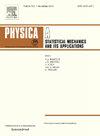Feedback control of a heterogeneous lattice hydrodynamic model with multi-visual field effect under cyber-attacks
IF 2.8
3区 物理与天体物理
Q2 PHYSICS, MULTIDISCIPLINARY
Physica A: Statistical Mechanics and its Applications
Pub Date : 2025-06-18
DOI:10.1016/j.physa.2025.130781
引用次数: 0
Abstract
As intelligent driving technology and vehicle communication systems advance rapidly, the future road networks are expected to be dominated by a heterogeneous traffic mix of connected autonomous vehicles (CAVs) and human-driven vehicles (HDVs). However, malicious cyber-attacks targeting CAVs can create discrepancies between the traffic data they receive and actual conditions, thereby increasing traffic risks. This study employs a lattice hydrodynamics framework that incorporates multi-visual field effects, proposing a model with a feedback control strategy to counteract the adverse effects of cyber-attacks. Linear stability analysis yields the neutral stability curve, while nonlinear analysis leads to a modified Korteweg-de Vries (mKdV) equation describing the evolution of traffic congestion near the critical point. Theoretical results are validated through numerical simulations under periodic boundary conditions. Additionally, power spectrum and spectral entropy analysis provide deeper insights into how the proportion of CAVs, cyber-attacks, and feedback control influence traffic stability. The simulations indicate that a higher CAV ratio can enhance system stability. Conversely, false traffic information received by the vehicle control unit can trigger traffic collapse or diminish traffic efficiency. The proposed feedback control strategy effectively alleviates these negative impacts from cyber-attacks, enhancing both the stability and efficiency of mixed traffic systems. These findings are further substantiated by power spectrum and spectral entropy analyses of density evolution.
网络攻击下具有多视场效应的非均质晶格水动力模型的反馈控制
随着智能驾驶技术和车辆通信系统的快速发展,未来的道路网络预计将由连接的自动驾驶汽车(cav)和人类驾驶汽车(hdv)的异构交通组合主导。然而,针对自动驾驶汽车的恶意网络攻击可能会造成它们接收到的流量数据与实际情况之间的差异,从而增加流量风险。本研究采用了包含多视野效应的晶格流体力学框架,提出了一个带有反馈控制策略的模型,以抵消网络攻击的不利影响。线性稳定性分析得到中性稳定性曲线,而非线性分析得到描述临界点附近交通拥堵演变的修正Korteweg-de Vries (mKdV)方程。通过周期边界条件下的数值模拟验证了理论结果。此外,功率谱和谱熵分析可以更深入地了解自动驾驶汽车、网络攻击和反馈控制的比例如何影响交通稳定性。仿真结果表明,较高的CAV比可以提高系统的稳定性。反之,车辆控制单元接收到的虚假交通信息会引发交通崩溃或降低交通效率。所提出的反馈控制策略有效地缓解了网络攻击的负面影响,提高了混合交通系统的稳定性和效率。密度演化的功率谱和谱熵分析进一步证实了这些发现。
本文章由计算机程序翻译,如有差异,请以英文原文为准。
求助全文
约1分钟内获得全文
求助全文
来源期刊
CiteScore
7.20
自引率
9.10%
发文量
852
审稿时长
6.6 months
期刊介绍:
Physica A: Statistical Mechanics and its Applications
Recognized by the European Physical Society
Physica A publishes research in the field of statistical mechanics and its applications.
Statistical mechanics sets out to explain the behaviour of macroscopic systems by studying the statistical properties of their microscopic constituents.
Applications of the techniques of statistical mechanics are widespread, and include: applications to physical systems such as solids, liquids and gases; applications to chemical and biological systems (colloids, interfaces, complex fluids, polymers and biopolymers, cell physics); and other interdisciplinary applications to for instance biological, economical and sociological systems.

 求助内容:
求助内容: 应助结果提醒方式:
应助结果提醒方式:


